You’ll find that external wall insulation (EWI) presents a significant environmental trade-off in UK buildings. While manufacturing generates 86kg of CO2 emissions per square meter initially, you can expect a 45-60% reduction in heating energy consumption, preventing 1.5-2 tonnes of CO2 emissions annually. Over their 25-30 year lifespan, EWI systems prevent 37-60 tonnes of carbon emissions. The environmental impact varies considerably based on material choices and installation methods, with emerging sustainable options reshaping the industry’s future.
Key Takeaways
- EWI systems reduce household carbon emissions by 1.5-2 tonnes annually, preventing 37-60 tonnes over their 25-30 year lifespan.
- Initial carbon costs from manufacturing and installation are typically offset within 2-5 years through reduced heating demands.
- Mineral wool insulation produces 86kg of CO2 per square meter, with petroleum-based materials generating even higher emissions.
- Most insulation materials end in landfills, causing long-term environmental concerns through chemical leaching and slow decomposition.
- Sustainable alternatives like hemp and recycled materials support circular economy principles and reduce environmental impact.
Carbon Footprint of EWI Manufacturing

While external wall insulation (EWI) systems help reduce a building’s energy consumption, their manufacturing process generates significant carbon emissions.
You’ll find that material sourcing plays an essential role in the overall environmental impact, with raw materials often traveling hundreds of miles before reaching production facilities.
The manufacturing processes involved in creating EWI components typically require high-energy operations.
You’re looking at approximately 86kg of CO2 emissions per square meter of mineral wool insulation produced, and even higher figures for petroleum-based materials.
When you factor in the energy needed for binding agents, protective coatings, and reinforcement meshes, the carbon footprint increases substantially.
However, you’ll be pleased to know that these initial carbon costs are usually offset within 2-5 years through reduced heating demands.
Energy Savings and Emissions Reduction
Despite the initial carbon costs of manufacturing, properly installed EWI systems deliver substantial energy savings and emissions reductions over their lifetime.
You’ll typically see a 45-60% reduction in your home’s heating energy consumption, which translates to significant carbon savings. These improvements in energy efficiency mean you’re preventing approximately 1.5-2 tonnes of CO2 emissions per year for an average UK home.
The environmental benefits compound over time.
With a lifespan of 25-30 years, your EWI system will help prevent 37-60 tonnes of carbon emissions throughout its service life.
You’re not just improving your home’s thermal performance; you’re joining a community of homeowners who are actively contributing to the UK’s carbon reduction targets and creating a more sustainable future for everyone.
Raw Material Extraction and Sustainability

As manufacturers extract raw materials for wall insulation, the environmental impact varies considerably by material type.
You’ll find that mineral wool requires intensive mining of basalt and dolomite, while fiberglass production demands significant quantities of silica sand. These traditional materials generate substantial CO2 emissions during extraction and processing.
You can now choose from emerging sustainable sourcing options that reduce environmental strain.
Material alternatives like hemp, sheep’s wool, and recycled cotton offer lower extraction impacts, as they’re either agricultural byproducts or repurposed waste.
When you’re selecting insulation, consider that recycled content in fiberglass can reach 80%, while cellulose insulation typically contains 85% post-consumer paper.
These eco-friendly alternatives help you minimize your project’s carbon footprint while supporting circular economy principles in the construction industry.
Installation Process Environmental Impact
Once insulation materials arrive on-site, their installation process generates distinct environmental impacts through equipment emissions, waste production, and potential chemical releases.
You’ll notice that different installation techniques affect your project’s carbon footprint. When you’re implementing external wall insulation, it’s vital to take into account both immediate and long-term environmental consequences.
- Electric drills and cutting tools release carbon emissions during the installation process
- Adhesive chemicals can emit volatile organic compounds (VOCs) into the atmosphere
- Packaging materials and off-cuts contribute to construction waste
- Water usage for mixing components impacts local resources
- Dust particles from cutting and fitting affect local air quality
The good news is that proper installation techniques markedly enhance energy efficiency, offsetting initial environmental impacts within 2-3 years through reduced heating and cooling demands.
Durability and Lifecycle Assessment

The lifespan of wall insulation materials directly impacts their overall environmental footprint, with most high-quality installations lasting 20-50 years before requiring replacement. You’ll find that material longevity varies notably based on the type and quality of insulation you choose.
| Material Type | Expected Lifespan | Carbon Footprint | Performance Rating | Recyclability |
|---|---|---|---|---|
| Mineral Wool | 40-50 years | Medium | Excellent | High |
| EPS | 25-30 years | High | Good | Medium |
| Natural Fiber | 20-25 years | Low | Fair | Very High |
| Spray Foam | 30-35 years | Very High | Excellent | Low |
| Glass Wool | 35-45 years | Medium | Very Good | High |
Performance evaluation shows that proper installation and maintenance are essential for maximizing your insulation’s environmental benefits and extending its useful life.
Waste Management and Disposal Challenges
While insulation materials significantly reduce energy consumption during their operational life, managing their disposal presents complex environmental challenges.
You’ll need to evaluate that most insulation materials end up in landfills, where they can take decades to decompose. Through waste reduction strategies and recycling initiatives, you can minimize this environmental impact.
- Compressed insulation materials forming towering mountains at disposal sites
- Shredded foam particles carried by wind across landfill boundaries
- Chemical leachate seeping into soil from degrading synthetic materials
- Specialized recycling equipment processing salvaged insulation
- Workers in protective gear carefully separating different insulation types
When you’re planning your insulation project, you’ll want to partner with contractors who participate in take-back programs and follow proper disposal protocols.
Impact on Urban Heat Islands

Beyond waste management concerns, proper wall insulation plays a significant role in combating urban heat island effects across metropolitan areas.
You’ll find that well-insulated buildings contribute to urban cooling by reducing the need for air conditioning, which typically releases excess heat into the surrounding environment.
When you’re considering external wall insulation, you’re actually participating in a collective effort to decrease city temperatures.
Studies show that buildings with proper insulation can reduce heat retention in urban areas by 2-3°C. This cooling effect is particularly noticeable during summer months when metropolitan areas typically experience temperatures 4-6°C higher than surrounding rural regions.
Through improved insulation, you’re helping create a more sustainable urban environment while simultaneously reducing your building’s energy demands.
Local Ecosystem and Biodiversity Effects
Installing proper wall insulation creates ripple effects throughout local ecosystems, with both positive and negative implications for biodiversity.
You’ll notice habitat disruption for wall-dwelling species during installation, which can trigger temporary species migration. However, research shows that when you incorporate wildlife-friendly features, you’re creating sustainable urban habitats.
- Small birds losing nesting spaces in wall cavities
- Bats relocating from traditional roost sites
- Native climbing plants adapting to new wall surfaces
- Insects establishing colonies in modified wall structures
- Urban pollinators finding new migration routes
While initial disruption is unavoidable, you’re contributing to long-term ecosystem stability through reduced carbon emissions.
By choosing eco-conscious installation methods and materials, you’ll help maintain local biodiversity while improving your building’s energy efficiency.
Consider installing artificial nesting boxes to offset temporary habitat loss.
UK Policy and Environmental Compliance
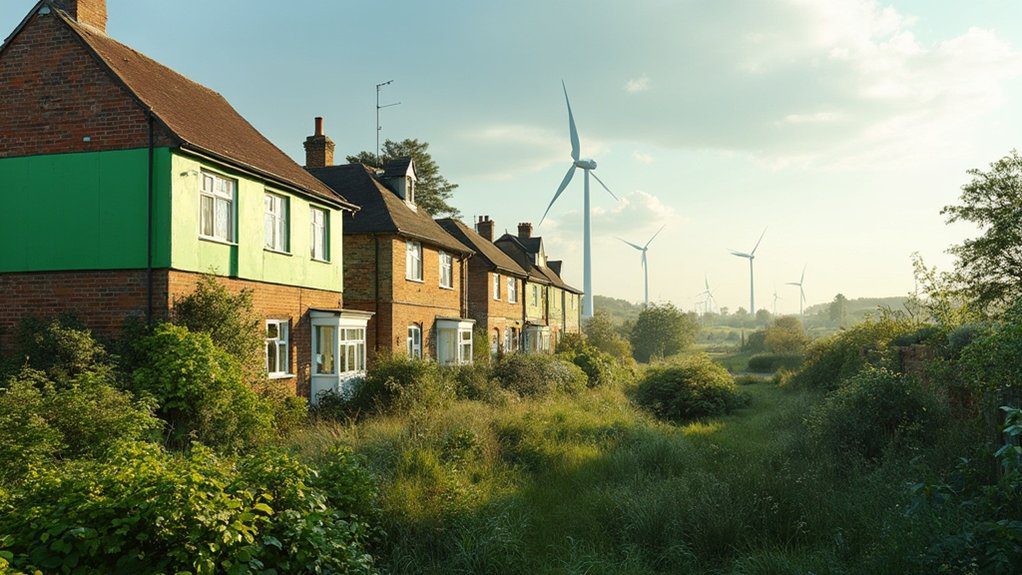
As UK building regulations continue to evolve, homeowners must navigate increasingly stringent environmental compliance standards for wall insulation.
You’ll need to guarantee your installation meets the latest policy frameworks, including the Building Regulations 2010 Part L and the Approved Document L1B for existing dwellings.
When you’re planning your wall insulation project, you’ll want to verify compliance with current U-value requirements, which specify minimum thermal performance standards.
You’re also required to follow local planning guidelines, particularly in conservation areas or listed buildings.
The government’s Future Homes Standard, coming into effect in 2025, will introduce even stricter compliance standards for energy efficiency.
Frequently Asked Questions
How Does External Wall Insulation Affect Indoor Air Quality?
You’ll need proper ventilation systems when adding external wall insulation, as it creates an airtight envelope that can trap indoor pollutants. Ensuring adequate air exchange is essential for maintaining healthy indoor air quality.
Can External Wall Insulation Increase a Property’s Market Value?
Like adding a golden seal of approval, your property’s value can climb substantially. Property appraisals show you’ll gain 6-15% in market value when you’ve got external wall insulation, plus you’ll join eco-conscious homeowners.
What Noise Reduction Benefits Does External Wall Insulation Provide?
You’ll experience significant noise reduction as external wall insulation materials can reduce outside noise by up to 50%. These soundproofing techniques create an effective barrier between you and external disturbances, enhancing your home’s comfort.
Does External Wall Insulation Require Planning Permission in Conservation Areas?
You’ll need planning permission in 95% of conservation areas when installing external wall insulation. Local planning regulations and conservation guidelines are strict to protect historical character, so you should consult your council first.
How Does External Wall Insulation Perform in Different UK Climate Zones?
You’ll find external wall insulation’s efficiency varies across UK climate zones, but it generally provides excellent climate adaptation benefits. It’s most effective in northern regions where you’ll experience greater heat retention and energy savings.
Conclusion
External wall insulation’s environmental impact in the UK presents a complex balance between manufacturing emissions and long-term benefits. You’ll find that EWI systems typically save 5.2 tonnes of CO2 annually per household, offsetting their production footprint within 2-3 years. As you address climate change targets, consider that proper installation and end-of-life management remain essential for maximizing EWI’s positive environmental contribution to the UK’s built environment.

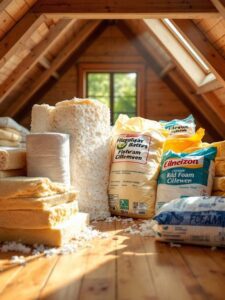
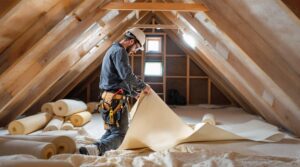
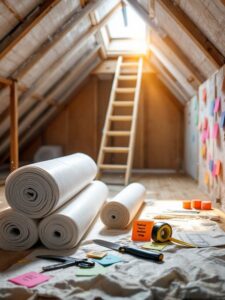
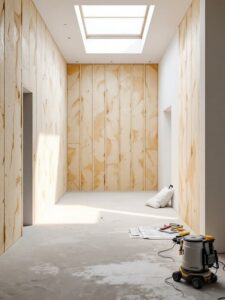



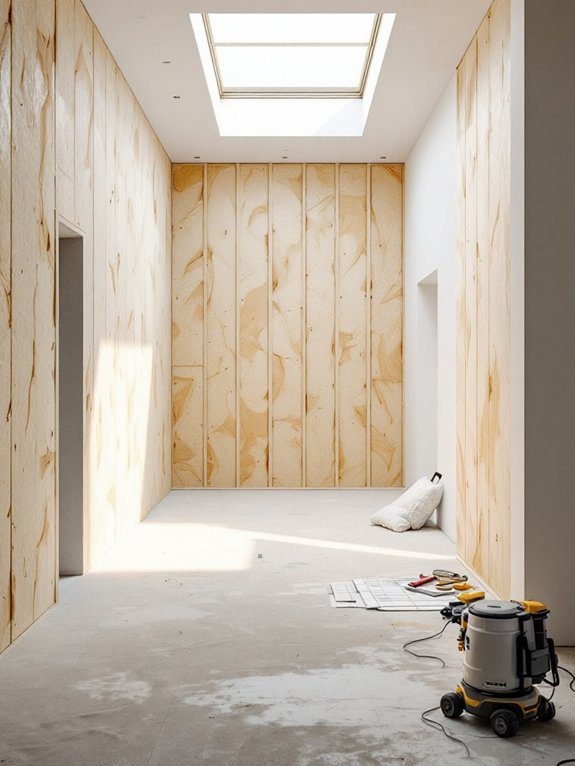
21 Responses
You could definitely see your enthusiasm in the paintings you write. The world hopes for more passionate writers such as you who aren’t afraid to say how they believe. All the time follow your heart. “The only way most people recognize their limits is by trespassing on them.” by Tom Morris.
I have read several just right stuff here. Certainly value bookmarking for revisiting. I wonder how so much effort you put to make any such wonderful informative website.
Please let me know if you’re looking for a article author for your blog. You have some really great articles and I feel I would be a good asset. If you ever want to take some of the load off, I’d love to write some articles for your blog in exchange for a link back to mine. Please shoot me an email if interested. Cheers!
Howdy would you mind stating which blog platform you’re working with? I’m looking to start my own blog in the near future but I’m having a difficult time making a decision between BlogEngine/Wordpress/B2evolution and Drupal. The reason I ask is because your design seems different then most blogs and I’m looking for something completely unique. P.S Sorry for being off-topic but I had to ask!
Hey there! I’ve been following your web site for a long time now and finally got the courage to go ahead and give you a shout out from Huffman Texas! Just wanted to mention keep up the fantastic work!
Thank you, I have just been searching for info approximately this topic for a long time and yours is the best I’ve came upon so far. But, what concerning the conclusion? Are you sure about the supply?
Hiya, I’m really glad I have found this information. Nowadays bloggers publish just about gossips and net and this is really frustrating. A good blog with exciting content, this is what I need. Thank you for keeping this web-site, I’ll be visiting it. Do you do newsletters? Can’t find it.
Its fantastic as your other content : D, thanks for putting up.
Hiya, I’m really glad I’ve found this info. Today bloggers publish only about gossips and internet and this is really annoying. A good blog with interesting content, that is what I need. Thank you for keeping this website, I’ll be visiting it. Do you do newsletters? Can not find it.
Some really marvelous work on behalf of the owner of this website , absolutely outstanding written content.
Can you be more specific about the content of your article? After reading it, I still have some doubts. Hope you can help me. https://www.binance.com/ka-GE/register?ref=ILE8IH9H
Absolutely composed subject material, Really enjoyed reading through.
Can you be more specific about the content of your article? After reading it, I still have some doubts. Hope you can help me. https://accounts.binance.info/ES_la/register?ref=VDVEQ78S
Some really nice and useful info on this internet site, besides I believe the design and style holds excellent features.
I got what you mean ,bookmarked, very nice internet site.
Thank you for sharing with us, I conceive this website truly stands out : D.
Your point of view caught my eye and was very interesting. Thanks. I have a question for you. https://www.binance.com/register?ref=IXBIAFVY
Way cool, some valid points! I appreciate you making this article available, the rest of the site is also high quality. Have a fun.
Good post but I was wondering if you could write a litte more on this topic? I’d be very grateful if you could elaborate a little bit further. Many thanks!
Good – I should definitely pronounce, impressed with your web site. I had no trouble navigating through all the tabs and related info ended up being truly easy to do to access. I recently found what I hoped for before you know it at all. Quite unusual. Is likely to appreciate it for those who add forums or anything, web site theme . a tones way for your client to communicate. Excellent task.
I have been absent for some time, but now I remember why I used to love this site. Thank you, I will try and check back more frequently. How frequently you update your site?